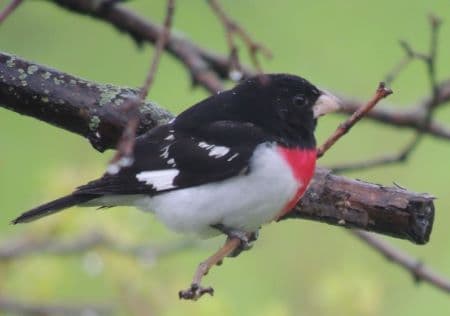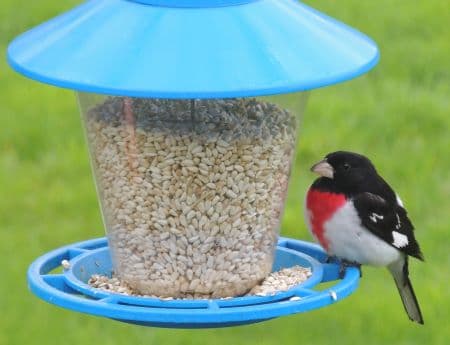
The Rose Breasted Grosbeak is a bird that is common at bird feeders in some areas. However, for others it’s a rare treat. It was decades before this avid bird watcher first saw one at the backyard feeder. The pretty, yet chunky male is readily identifiable. At a quick glance, the rather plain female can be easily mistaken for an overweight, slightly large sparrow. If grosbeaks are in your area, fill a feeder with sunflower or safflower seeds. Place wild berries in places where you can view the birds, and you will be rewarded.
Rose Breasted Grosbeaks are found from the northeastern U.S., up into eastern and central Canada. Grosbeaks are migratory birds, traveling south to tropical areas in Central and South America in the winter.
Grosbeaks live in woodlands and at the edge of forests, including both deciduous and conifer trees. They can be found in backyards and parks that offer some trees and shrubs for both nesting and protection.
The pretty and colorful male Rose Breasted Grosbeak grows to 7-8 inches long. It has a wingspan of 11-13 inches.
Mature males are readily identifiable by their black back and white underbelly, with a bright rose-red on their breast. His head is solid jet black. Females are less distinguishable, having a brown back streaked with black, and a greyish-yellowish underbelly streaked with dark brown. Females have a white stripe over their eyes. Both the male and female have a square tail. These birds have short, stout, pale, triangular beaks.
Note: As a result of their short beak, they cannot reach seeds in some feeders. Platform feeders and those with wide openings are best for these birds.
This grosbeak’s song is similar to a robin.
In the wild, the average lifespan of Rose Breasted Grosbeaks is 12-13 years. However, some grosbeaks have been known to live much longer.
State Birds: Surprisingly, grosbeaks are not listed as the official state bird for ANY of the U.S. states!

Grosbeaks eat a wide variety of insects, seeds, and berries. Sunflower and safflower seeds are their favorites. They also like peanuts. They consume a large number of berries in late summer and early fall when they are most abundant. Young hatchlings are fed mostly insects.
Rose Breasted Grosbeaks first mate in the spring. They may have 1-2 broods throughout the season. The female does most of the nest building. She will lay 3-5 pale green eggs, with reddish-brown spots. The incubation period is 13-14 days. Males will sit on the nest some of the time. Both parents will feed the young hatchlings a diet consisting mostly of insects. The young birds will leave the nest about 9-12 days after hatching. The parents will continue to feed the young birds for another several weeks.
Falcons, hawks, and owls are common predators.
Find much more information about your favorite birds and how to attract them t your backyard:

©1999-2024 GardenersNet.Com, All Rights Reserved